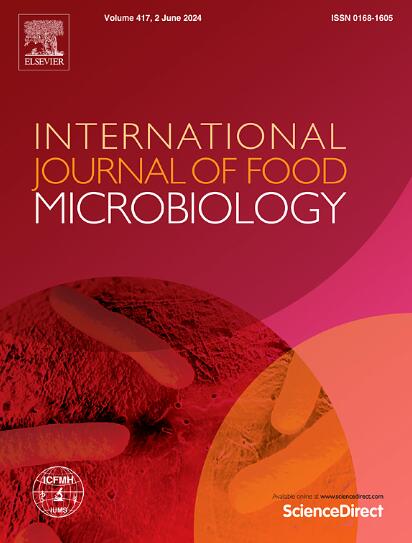Emergence of multidrug resistant Escherichia coli coharboring fosA3 and ESBL genes from retail ducks along slaughter line
IF 5.2
1区 农林科学
Q1 FOOD SCIENCE & TECHNOLOGY
International journal of food microbiology
Pub Date : 2025-03-29
DOI:10.1016/j.ijfoodmicro.2025.111185
引用次数: 0
Abstract
The excessive and indiscriminate use of antimicrobial agents in poultry production has increased antimicrobial resistance in E. coli, posing a significant threat to public health. This study investigated the prevalence of multidrug-resistant (MDR) E. coli co-harboring fosA3 and extended-spectrum β-lactamases (ESBLs) genes in large-scale retail duck slaughterhouses in Sichuan Province, China. The antimicrobial susceptibility to 9 categories and 16 types of antimicrobial agents was assessed by using the broth microdilution method. Phylogenetic grouping and pulsed-field gel electrophoresis (PFGE) were used to investigate the phylogenetic groups and genetic characteristics of the isolates. Moreover, whole-genome sequencing (WGS) was performed on 35 representative E. coli isolates. Among 1, 059 samples collected, 895 E. coli were isolated by MacConkey (MAC) agar and eosin methylene blue (EMB) agar and PCR identification, and 150 strains of MDR E. coli co-carrying fosA3 and ESBL genes were finally screened for further analysis. The results indicated that 141 isolates were resistant to fosfomycin and exhibited high resistance to β-lactam antibiotics. All isolates demonstrated MDR patterns, with 148 isolates resistant to six or more classes of antimicrobial agents. The majority (70/150, 46.67 %) belonged to phylogenetic group B1. Based on an 85 % similarity threshold, all isolates were categorized into 40 distinct PFGE types. Genomic analysis revealed 27 different serotypes and 19 sequence types (STs), with O8 (14.29 %, 5/35) and ST155 (22.86 %, 8/35) being the most common. The IncFIB (AP001918) was the most prevalent plasmid replicon type, identified in 74.29 % (26/35) of the isolates. In addition, 49 acquired antimicrobial resistance genes (ARGs) associated with resistance to 11 types of antimicrobial agents were identified and chromosomal mutation of p.S83L in gyrA gene (88.57 %, 31/35) was the most common. Furthermore, 110 virulence factors (VFs) were identified, with those related to iron uptake and storage, adhesion, secretion and endotoxin production being the most prevalent. This study underscored the importance of rational use of antimicrobial agents in poultry farming and provided critical insights into the distribution of ARGs and VFs among retail duck-derived MDR E. coli.
从屠宰线上的零售鸭中出现含有fosA3和ESBL基因的多重耐药大肠杆菌
在家禽生产中过度和不加选择地使用抗菌剂,增加了大肠杆菌的抗菌素耐药性,对公众健康构成重大威胁。本研究调查了四川省大型零售鸭屠宰场中共携带fosA3和广谱β-内酰胺酶(ESBLs)基因的多重耐药(MDR)大肠杆菌的流行情况。采用微量肉汤稀释法对9大类16种抗菌药物进行敏感性评价。采用系统发育分组和脉冲场凝胶电泳(PFGE)对分离菌株的系统发育类群和遗传特征进行了研究。此外,对35株具有代表性的大肠杆菌进行了全基因组测序。通过MacConkey (MAC)琼脂和eosin亚甲基蓝(EMB)琼脂分离得到895株大肠杆菌,最终筛选出150株共携带fosA3和ESBL基因的MDR大肠杆菌进行进一步分析。结果表明,141株菌株对磷霉素耐药,对β-内酰胺类抗生素耐药。所有分离株均表现出耐多药模式,其中148株对6类或更多种抗菌药物具有耐药性。大多数(70/150,46.67%)属于系统发育类群B1。基于85%的相似性阈值,所有分离株被划分为40种不同的PFGE类型。基因组分析显示27种不同的血清型和19种序列型(STs),其中O8(14.29%, 5/35)和ST155(22.86%, 8/35)最为常见。IncFIB (AP001918)是最常见的质粒复制子类型,占74.29%(26/35)。此外,共鉴定出与11种抗菌药物耐药相关的49个获得性耐药基因(ARGs),其中以gyrA基因p.S83L染色体突变最为常见(88.57%,31/35)。此外,鉴定出110个毒力因子(VFs),其中与铁的摄取和储存、粘附、分泌和内毒素产生有关的毒力因子最为普遍。该研究强调了在家禽养殖中合理使用抗菌药物的重要性,并为零售鸭源耐多药大肠杆菌中arg和VFs的分布提供了重要见解。
本文章由计算机程序翻译,如有差异,请以英文原文为准。
求助全文
约1分钟内获得全文
求助全文
来源期刊
CiteScore
10.40
自引率
5.60%
发文量
322
审稿时长
65 days
期刊介绍:
The International Journal of Food Microbiology publishes papers dealing with all aspects of food microbiology. Articles must present information that is novel, has high impact and interest, and is of high scientific quality. They should provide scientific or technological advancement in the specific field of interest of the journal and enhance its strong international reputation. Preliminary or confirmatory results as well as contributions not strictly related to food microbiology will not be considered for publication.

 求助内容:
求助内容: 应助结果提醒方式:
应助结果提醒方式:


